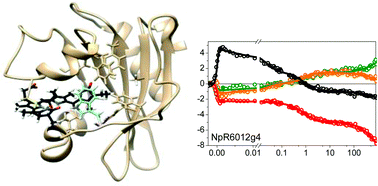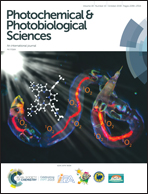Conservation and diversity in the secondary forward photodynamics of red/green cyanobacteriochromes†
Abstract
Cyanobacteriochromes (CBCRs) are photosensitive proteins that are distantly related to the phytochrome family of photoreceptors and, like phytochromes, exhibit photoactivity initiated by the excited-state photoisomerization of a covalently bound bilin chromophore. The canonical red/green photoswitching sub-family is the most studied class of CBCRs studied to date. Recently, a comparative study of the ultrafast (100 fs–10 ns) forward photodynamics of nine red/green photoswitching CBCR domains isolated from Nostoc punctiforme were reported (S. M. Gottlieb, P. W. Kim, C.-W. Chang, S. J. Hanke, R. J. Hayer, N. C. Rockwell, S. S. Martin, J. C. Lagarias and D. S. Larsen, Conservation and Diversity in the Primary Forward Photodynamics of Red/Green Cyanobacteriochromes, Biochemistry, 2015, 54, 1028–1042). We extend this study by characterizing the secondary (10 ns–1 ms) forward photodynamics of eight red/green photoswitching CBCRs from N. punctiforme with broadband time-resolved absorption spectroscopy. We demonstrate that the dynamics of these representative red/green CBCRs can be separated into two coexisting pathways involving a photoactive pathway that is successful in generating the terminal light-adapted 15EPg population and an unsuccessful pathway that stalls after generating a meta-stable Lumi-Of intermediate. The photoactive pathway evolves through a similar mechanism from excitation of the dark-adapted 15ZPr state to generate a far-red absorbing Lumi-Rf and then via a succession of blue-shifting photointermediates to ultimately generate the 15EPg state. This suggests a steady deviation from planarity of the bilin chromophore during the dynamics. While, the general mechanism for this evolution is conserved among these CBCBs, the timescales of these dynamics deviate significantly. Only half of the characterized CBCRs exhibit the unproductive pathways due to photoexcitation of dark-adapted 15ZPo sub-population that upon photoexcitation generates a meta-stable Lumi-Of intermediate, which eventually decays back to the 15ZPo subpopulation. 15ZPo is ascribed the horizontal Asp657 configuration that disrupts H-bonding with the chromophore in the dark-adapted state; its presence can be identified via enhanced absorption of high-energy tail of the electronic absorption spectrum.



 Please wait while we load your content...
Please wait while we load your content...